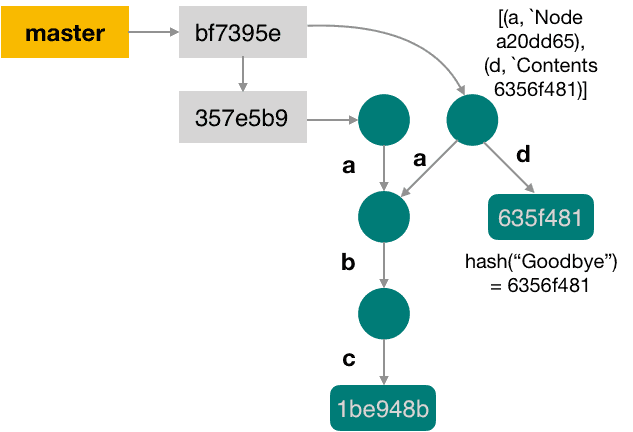Two types of stores are used in Irmin: the block and the reference store.
The Block Store
This is the type of store used for the commits, nodes, and contents. The block store is persistent and content addressable. Persistence means that updating a data structure returns a new one, which shares its subparts as much as possible with the original structure in order to avoid the cost of extra allocations. A side effect is that a history of updates is maintained as well.
It is also a content addressable store, as values (be it contents, commits,
or nodes) are stored as a pair (hash(value), value). Therefore, a value can
be accessed using its hash.
Irmin contains a collection of block stores, but you can create your own using the interface Irmin.Content_addressable.S, as long as the following are guaranteed:
-
Reads using the same key return the same value.
-
Writes of the same value return the same key.
The Reference Store
The reference store is a mutable store used for branches. As in Git, branches are tags added
to commits. A default branch (main) is always available in Irmin. Branches
are useful when multiple processes access the store, as they keep track of the state
of each process. This type of store is also called an atomic write store:
two independent processes can do some local modifications, but updating the same
branch is an atomic and concurrent operation.
Branches are stored as pairs of (hash(commit), branch) in the reference store.
As for the block store, you can choose a reference store from the ones Irmin provides,
or you can create your own using the interface [Irmin.Atomic_write.S].
The operations you have to implement need to satisfy some constraints:
-
Concurrent reads of the same branch name return the same hash. Updates of a branch name to a given commit should be sequentially consistent. Subsequent reads of a branch name should always result in the last hash that has been written.
-
Writes are implemented using two operations:
setandtest_and_set.setupdates a branch name to a given hash but provides no guarantees in the case of concurrent writes.
test_and_set is a two step operation: (1) it first checks the
current hash of a branch name, and (2) then it updates the branch name to a new
hash. This two-step operation must be atomic to guarantee that, in case of
concurrent writes, only the fastest write updates the branch name.
Ensuring that test_and_set is atomic can be difficult, as the
POSIX interface does not provide such an operation. [Irmin_fs_unix] uses a
dotlocking optimistic strategy (i.e., creating a file can be
done atomically on POSIX filesystems).
Combining the Two
Commits, nodes, contents, and branches stores combine in an Irmin store.
As we have seen in our examples so far, Irmin uses trees to store its contents.
The leaves of the tree contain the contents, while the nodes encode the path
from the root to the contents. Commits are represented as special
nodes in the tree. For instance, the contents we commited to a Mem_store in
the Getting Started section:
let main () =
let* repo = Mem_store.Repo.v config in
let* t = Mem_store.main repo in
Mem_store.set_exn t ["a"; "b"; "c"] "Hello, Irmin!" ~info:(info "my first commit")Let's add a new commit:
let new_commit t =
Mem_store.set_exn t ["d"] "Goodbye!" ~info:(info "my second commit")Then the store changes to
The main branch references the latest commit.
As mentioned, Irmin has a few types of stores available: the in-memory store and the Git store, as covered in the Getting started tutorial, but also others that you can explore on GitHub. In the next section, we will create our own Irmin stores.

